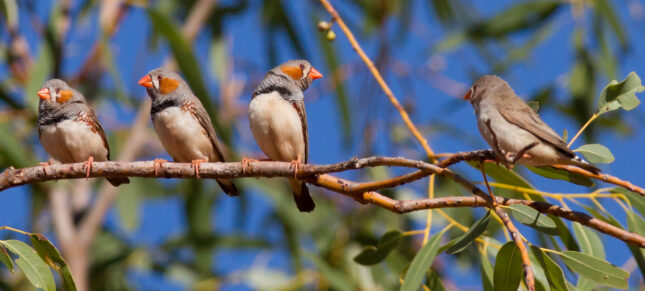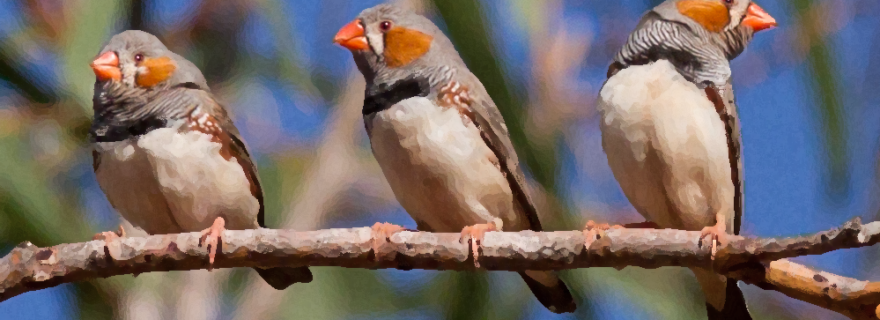From parroting to grammar
Animals communicate with each other in complex and intricate ways. What do their vocal abilities tell us about how vocal learning and language in humans may have evolved?
Human communication is bewilderingly complex. We have to pick up sounds, recognize rhythms, understand rules, remember patterns, deduct information and then respond by making our own sounds.
But there is a lot more to it. Our communication is not purely instinctive, contrary to many other sounds that animals make. Children have to learn a language and if they’re not exposed to it they will not be able to speak later on. The process that enables us to learn the most important ways of communication from others is called vocal learning. This is the ability to acquire new sounds by imitating and vocalizing.
Animal kingdom
Even though learning and producing sounds it widespread in the animal kingdom, vocal learning is actually quite rare. Most primates, like chimpanzees, don’t learn vocally like humans do. A chimp that grows up in isolation makes about the same noises that a chimp would make in the wild, surrounded by relatives. We don’t share our complex language learning process with our closest cousins in the evolutionary tree, but this quality has evolved in some other parts of said tree.
Whales, dolphins, bats, hummingbirds, parrots and songbirds are animals that certainly learn complex sounds. For example, songbirds don’t know their songs instinctively, but they need to learn this from a teacher. The song of a bird is very similar to the song of their teacher. And a zebra finch that never had a proper example will not make it far in the music world.
Intonation
We are certainly not the only ones that practice vocal learning, but the song of a bird is still not comparable to our language. We aren’t just parrots copying sounds, but we also recognize certain patterns and structures. And we can also use these patterns to link new words and rhythms to structures we already know.
An important example is intonation. By emphasizing syllables, employing pitch, frequency and length, we can give structure to a continuous stream of speech. Intonation helps us interpret a sentence. For instance, the word 'minute' has a very different meaning depending on how you say it. Are you talking about a measurement of time or is something very small? Intonation also plays an important role in recognizing questions. When the pitch goes up at the end of the sentence, we intuitively know it was meant as a question.
Go or no go?
Intonation is a very complex process and requires many different cognitive capacities. But just like vocal learning it is still not unique to humans. Research by University Leiden done by people like Dr. Michelle Spierings shows that zebra finches not only copy their teacher, but are also able to recognize human intonation.
By using a Go/No-go system the birds learned to push a button when they heard a questioning sentence, one that goes up in pitch towards the end of the sentence.It’s crucial that they’re able to recognize these structures. “When you present a new question that they’ve never heard before, they are able to correctly categorize this based on intonation.” Spierings explains.


I tired am
But what about grammar? A painful discovery for young children in primary school is that language isn’t just intuitive, but that it’s sustained by complex rules and structures. Grammar is an umbrella term for structures, rules and patterns of language. Most grammar will probably never be learned by animals. A zebra finch won't learn the difference between there, their and they’re. But simple patterns, like the XYX-structure, can be considered as rudimentary grammar. This is the pattern of noun-verb-noun, for example: “I am tired”. We recognize it differs from a XXY-structure: “I tired am”.
Grammatical structures in birds have also been researched by Michelle Spierings. Even though these simple XYX- and XXY- structures are still too complex for zebra finches, parakeets have been shown to recognize them. Human sentences are too slow for them, but short sound fragments that have alternating pitches do work.It is not nearly as intricate as human grammatical structures, but it shows a sensitivity, or even a cognitive basis for recognizing and generalizing patterns shared with animals.
Insight
Research into animal keeps showing new insights: “Many processes that are necessary for language are slowly being uncovered in more and more species. There are animals that can distinguish words, recognize structures and perceive intonation, even though there is not a singular species that has it like humans.” is the conclusion of Michelle Spierings about the development in linguistic research.
We realize more and more that we share essential parts of our language, like vocal learning, intonation recognition and grammatical structure, with other animals. Eventually this research into these similarities can teach us more about the development and the learning of our language. Because it’s surprising how little we know.
Written language came long after spoken language, and of course there are no fossil records of the development of language. And vocal communication isn’t present in other primates.But by finding out how vocal learning and language came about in other animal species we might find out more about ourselves.






0 Comments
Add a comment